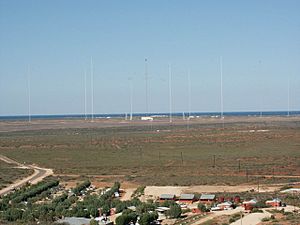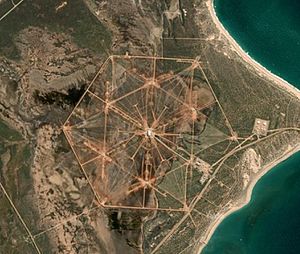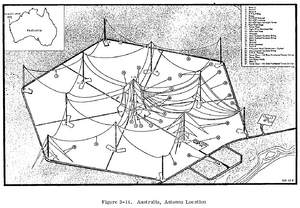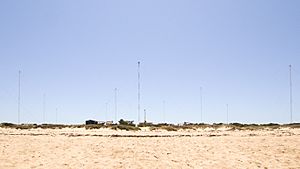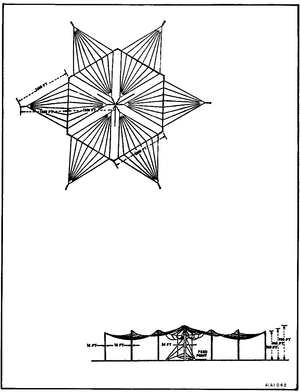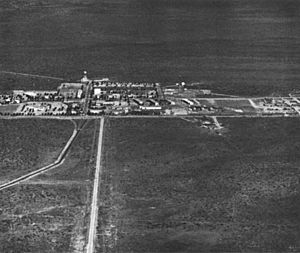Naval Communication Station Harold E. Holt facts for kids
The Naval Communication Station Harold E. Holt is a very important base in Australia. It's found on the northwest coast, about 6 kilometers (4 miles) north of a town called Exmouth, Western Australia. The town of Exmouth was actually built at the same time as the station. This was to help support the base and give homes to the families of the US Navy people working there.
This station sends out special radio signals called very low frequency (VLF) waves. These signals help United States Navy and Royal Australian Navy ships and submarines communicate when they are in the western Pacific Ocean and eastern Indian Ocean. The station uses a frequency of 19.8 kHz. It's super powerful, with a transmission power of 1 megawatt! This makes it the strongest radio station in the Southern Hemisphere.
Giant Radio Towers at Harold E. Holt
The station has thirteen really tall radio towers. The tallest one is called Tower Zero. It stands at an amazing 387 meters (1,270 feet) tall! For many years, it was the tallest man-made structure in the Southern Hemisphere.
Around Tower Zero, there are six other towers, each 364 meters (1,194 feet) tall. They are placed in a hexagon shape. Then, six more towers, each 304 meters (997 feet) tall, form a bigger hexagon around Tower Zero.
These towers are held up by many strong wires called guy wires. In 2009, new roads were built at the station to help replace these guy wires, as they had gotten old. The station's antenna system is like a giant spiderweb of wires. Buried underground beneath the antennas is a huge copper mat, about 386 kilometers (240 miles) long! This helps the radio signals work properly.
History of the Station
The land for this US base was first agreed upon in 1963 by Sir Garfield Barwick, an Australian Minister, and US Ambassador William Battle. The station officially opened on September 16, 1967. At the opening ceremony, the US Ambassador and the Prime Minister of Australia, Harold Holt, were there. A very small payment, called "peppercorn rent," was made for the first year of using the base.
Just a year later, on September 20, 1968, the station was officially renamed. It became the US Naval Communication Station Harold E. Holt. This was done to remember Harold Holt, who was the Prime Minister of Australia. He went missing while swimming and was believed to have drowned, just three months after the station opened.
In 1974, Australia and the US made some changes to how the base was run. An Australian Navy officer became the Deputy Commander of the base. Also, Australian staff started to take on more roles in the station's technical and maintenance jobs. This showed a stronger partnership between the two countries.
In May 1974, many people came to North West Cape to protest. They wanted to show that the base belonged to the Australian people. During this protest, the Eureka Flag was flown over the base, and many people were arrested. Songs were even written about not wanting foreign military bases in Australia. From 1967 until 1992, a special US Naval Security Group was also at the facility.
Over the years, people in Western Australia sometimes questioned having foreign military bases in their state. In 1974, the "U.S." was dropped from the station's official name. This was because Australia and the US started running it together. In 1991, Australia and the US agreed that the facility would become an Australian Naval Communication Station by 1999. This change began in 1992 when an Australian Navy officer took command. Most US Navy personnel left in 1993.
In July 2002, the Royal Australian Navy handed over the station's operation to a different group called the Defence Materiel Organisation. Today, a company called Raytheon Australia runs the base under a contract. In 2008, Australia and the US signed a new agreement to keep using the facility together for the next 25 years.
Future Plans and Space Tracking
The Harold E. Holt station has also become important for tracking things in space. In 2013, it was announced that the Space Surveillance Telescope (SST) would be moved to the station. This telescope is part of the United States Space Surveillance Network. It helps keep an eye on objects in space. The SST was expected to be ready for use in 2016 and became operational in 2020.
A special C-Band Space Surveillance Radar is also being installed at the station. Once it's finished, Royal Australian Air Force staff will operate it from RAAF Base Edinburgh. This radar will help track objects and debris in space, which is very important for keeping satellites safe.


